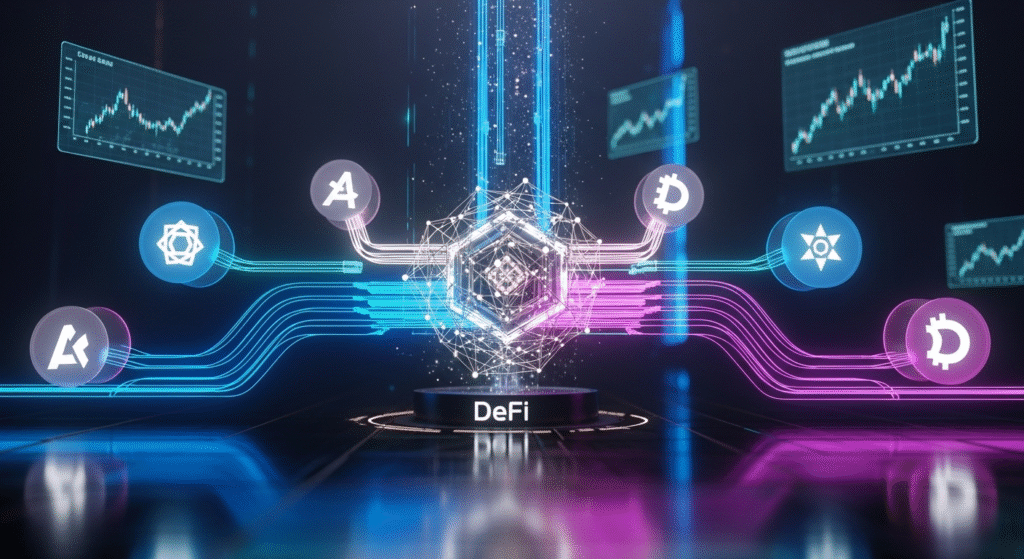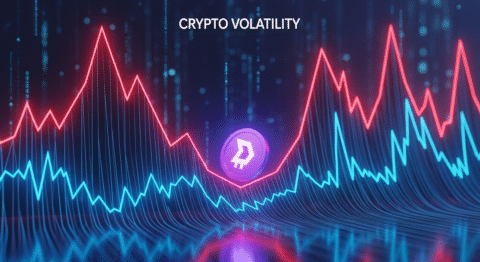DeFi Protocols: 7 Secrets for Altcoin Gains
Did you know that DeFi Protocols have the potential to unlock significant altcoin gains, often outperforming established cryptocurrencies? In a market constantly buzzing with the next big meme coin or airdrop opportunity, how can the average investor navigate the complexities and discover genuine, sustainable profit potential? Many believe that altcoin investing is purely speculative, a lottery ticket in the digital asset space. However, by understanding and leveraging the power of DeFi Protocols, you can empower yourself with strategies that move beyond mere luck and tap into the fundamental value creation happening within decentralized finance. advantage.
Crypto Market Overview
The cryptocurrency market, as of recent data, is demonstrating a dynamic and evolving landscape. While Bitcoin and Ethereum continue to dominate headlines, the growth narrative in the altcoin space is undeniable. We’re witnessing a significant surge in interest and investment across various altcoin categories, from utility tokens empowering new blockchain applications to the ever-vibrant meme coin sector that continues to surprise with its community-driven momentum. Recent trends indicate a growing appetite for riskier, yet potentially more rewarding, assets as investors seek higher yields and market differentiation. Airdrops, a popular method for token distribution, are also experiencing a resurgence, offering early adopters a chance to acquire new digital assets with minimal upfront investment.
Key market indicators show a healthy appetite for innovation. Decentralized Finance (DeFi) protocols, in particular, are at the forefront of this evolution, driving innovation in lending, borrowing, trading, and yield generation. The total value locked (TVL) in DeFi has seen substantial growth, underscoring the increasing adoption and utility of these decentralized applications. The correlation between the adoption of robust DeFi Protocols and the performance of their native DeFi tokens is becoming increasingly apparent, suggesting that understanding these protocols is crucial for identifying promising altcoin opportunities.

The Core Concept: How DeFi Protocols Actually Work
To truly understand how to leverage DeFi Protocols for altcoin gains, we first need a solid grasp of what they are and how they operate.
What Are Altcoins / Meme Coins / Airdrops?
Altcoins: The term “altcoin” (alternative coin) refers to any cryptocurrency other than Bitcoin. While early altcoins aimed to improve upon Bitcoin’s perceived limitations, today, the altcoin market encompasses a vast spectrum of projects with diverse use cases. These range from smart contract platforms enabling decentralized applications (dApps) to privacy-focused coins, stablecoins, and utility tokens that power specific ecosystems. The success of an altcoin fundamentally relies on its utility, development team, community, and the underlying problem it seeks to solve.
Meme Coins: Meme coins are a unique sub-category of altcoins that often originate from internet memes or social media trends. While many meme coins initially lack inherent utility or a strong technological foundation, their value can be heavily influenced by community sentiment, social media hype, and speculative trading. Dogecoin and Shiba Inu are prime examples. Their rapid price swings highlight both the potential for massive gains and extreme risks, often driven by viral marketing and community engagement rather than fundamental value.
Airdrops: Airdrops are a promotional strategy used by cryptocurrency projects to distribute free tokens to existing holders of a specific cryptocurrency or to users who perform certain actions (like signing up for a newsletter or holding a certain wallet balance). They are a common way for new projects to gain traction, build a community, and decentralize their token distribution from the outset. For users, airdrops can be a low-risk way to discover and acquire new DeFi tokens, potentially leading to significant gains if the distributed tokens appreciate in value.
Key Components & Technologies
The foundation for DeFi Protocols and the altcoins they support lies in several core technological components:
Blockchain Technology: At its heart, decentralization relies on blockchain, a distributed, immutable ledger. This technology ensures transparency, security, and resistance to censorship for all transactions and smart contract executions. Different blockchains offer varying features, consensus mechanisms (like Proof-of-Work or Proof-of-Stake), and transaction speeds, each influencing the performance and capabilities of the DeFi tokens built on them.
Smart Contracts: These are self-executing contracts with the terms of the agreement directly written into code. They run on the blockchain and automatically execute actions when predefined conditions are met. Smart contracts are the backbone of most DeFi Protocols, automating everything from lending and borrowing to trading and staking. Projects like Ethereum have pioneered smart contract functionality, enabling the creation of complex decentralized applications.
Decentralized Applications (dApps): These are applications powered by smart contracts on a blockchain. DeFi dApps offer financial services without intermediaries like banks. Examples include decentralized exchanges (DEXs) for trading DeFi tokens, lending protocols for earning interest on crypto, and yield farming platforms. The innovation within dApps directly impacts the utility and demand for the underlying DeFi tokens.
Tokenomics: This refers to the economic design and governance of a cryptocurrency. Well-designed tokenomics ensure sustainability, incentivize participation, and align the interests of token holders with the project’s growth. Understanding tokenomics is crucial for evaluating an altcoin’s long-term viability and potential for price appreciation.
The Data-Driven Perspective
To truly harness the power of DeFi Protocols for altcoin gains, a data-driven approach is paramount. Relying solely on hype or anecdotal evidence is a recipe for disappointment.
Market Data & Trends
The altcoin market has consistently shown periods of explosive growth. For instance, during bull runs, many altcoins have delivered returns far exceeding Bitcoin’s gains. Analyzing historical data reveals that projects with strong foundational technology, active development, and growing community adoption often lead the charge.
DeFi TVL Growth: The Total Value Locked (TVL) in DeFi protocols serves as a vital indicator of user adoption and capital inflow. Looking at aggregated DeFi data platforms (like DeFi Llama), we can observe that during periods of market expansion, TVL increases significantly, often driven by new protocols and the increased use of existing ones for yield generation. This increased activity directly benefits the DeFi tokens associated with these protocols.
Airdrop Value Tracking: While difficult to track systematically, retrospective analysis of significant airdrops often shows that tokens received for free by early participants have subsequently experienced substantial price appreciation. For example, early airdrops from major DeFi platforms have, at times, been worth thousands of dollars to recipients. Identifying potential future airdrop opportunities requires staying informed about nascent projects employing this distribution strategy.
Meme Coin Volatility Analysis: Data on meme coins highlights their extreme volatility. While some skyrocket based on social media virality, data shows many also crash dramatically once the hype fades. Success here often depends on timing and the ability to capitalize on short-term trends, which is inherently riskier.
Tokenomics & Market Health
Understanding the underlying tokenomics of DeFi tokens is critical for assessing their potential for sustainable gains.
Supply and Demand Dynamics: A limited supply with increasing demand generally leads to price appreciation. Projects with deflationary mechanisms (like token burns) or capped supply can create scarcity. Conversely, projects with high inflation rates or a large circulating supply might struggle to maintain or increase their value unless demand outpaces it significantly.
Utility and Value Accrual: The most robust altcoins have clear utility within their ecosystem. This could be governance rights (voting on protocol changes), staking rewards (earning passive income by locking tokens), transaction fees, or access to specific services. When a DeFi token is intrinsically linked to the success and usage of a protocol, its value is more likely to grow. Analyzing transaction volumes, user growth, and the actual use of dApps can provide insights into this.
Decentralized Governance: Projects that incorporate strong decentralized governance, where token holders can propose and vote on changes, tend to be more resilient and community-driven. This participatory model can foster long-term loyalty and development, positively impacting the DeFi tokens.
7 Secrets for Altcoin Gains Using DeFi Protocols
Now, let’s dive into the actionable strategies that can help you leverage DeFi Protocols for altcoin gains.
Secret 1: Yield Farming & Liquidity Provision
Yield farming involves providing liquidity to decentralized exchanges (DEXs) or lending protocols in exchange for rewards, often denominated in the protocol’s native DeFi tokens. By depositing pairs of tokens into liquidity pools, you earn trading fees and often additional token rewards.
- How it works: When you provide liquidity, you enable trading for a specific pair of assets on a DEX. As users trade that pair, you earn a portion of the trading fees. Many protocols also offer “liquidity mining” rewards, which are extra tokens distributed to incentivize providing liquidity.
- Data Insight: Research protocols with high Annual Percentage Yields (APYs) but also understand the underlying mechanisms. Look for protocols with strong trading volumes and sustainable reward structures. Platforms like APY.vision can help you track your performance and identify lucrative opportunities.
- Actionable Tip: Start with stablecoin pairs or pairs involving established cryptocurrencies like ETH/USDC to mitigate impermanent loss risk. As you gain experience, explore farming opportunities on emerging chains with high APYs but be mindful of the associated smart contract and economic risks.
Secret 2: Staking for Passive Income (and Governance)
Staking involves locking up your DeFi tokens to support the network’s operations and earn rewards. This is common on Proof-of-Stake (PoS) blockchains. Many DeFi platforms also allow you to stake their native tokens to earn more tokens or a share of protocol fees.
- How it works: By staking your tokens, you contribute to the network’s security and efficiency. In return, you receive newly minted tokens or transaction fees as a reward. Many staked tokens also grant governance rights, allowing you to vote on protocol proposals.
- Data Insight: Compare staking APYs across different protocols. Consider the lock-up period, potential slashing penalties (for validators), and the inflation rate of the staked token.
- Actionable Tip: Identify promising altcoins built on PoS networks or those with robust staking mechanisms. Staking not only provides passive income but also aligns you with the long-term success of the project. Consider staking tokens of platforms you believe will grow significantly.
Secret 3: Participating in ICOs/IDOs/IEOs Strategically
Initial Coin Offerings (ICOs), Initial DEX Offerings (IDOs), and Initial Exchange Offerings (IEOs) are ways to invest in new DeFi tokens before they hit the open market. Done correctly, these can offer significant early-stage gains.
- How it works: These are fundraising events where projects sell a portion of their tokens to early investors. IDOs, in particular, are becoming popular, leveraging decentralized exchanges for token distribution.
- Data Insight: Success here hinges on thorough due diligence. Analyze the project’s whitepaper, team, tokenomics, roadmap, and community engagement. Look for projects that have already demonstrated traction or partnerships.
- Actionable Tip: Participate in IDOs through reputable launchpads that vet projects rigorously. Diversify your investments across several early-stage projects rather than concentrating on one. Be aware of the vesting schedules for tokens received, as this can affect immediate sell pressure.
Secret 4: Leveraging Decentralized Lending Protocols
DeFi lending protocols allow you to earn interest on your crypto assets by lending them to borrowers, or to borrow crypto by providing collateral. This creates opportunities for both lenders and borrowers to optimize their holdings.
- How it works: You deposit your crypto into a lending pool on a DeFi protocol (like Aave or Compound). Borrowers then access these funds by providing collateral, paying interest which is distributed to lenders.
- Data Insight: Compare interest rates offered by different lending protocols. Consider the collateralization ratios required to borrow, the risk of liquidation, and the security audits of the protocol.
- Actionable Tip: Lend stablecoins to earn a relatively stable yield with lower risk. If you have long-term conviction in an altcoin, consider lending it out. Alternatively, you can borrow stablecoins against your altcoin collateral to reinvest or cover expenses without selling, but this carries liquidation risk.
Secret 5: Navigating Airdrop Opportunities
Airdrops remain a popular way to acquire new DeFi tokens. Early adopters and active users of new protocols are often rewarded.
- How it works: Projects announce criteria for receiving tokens, which might include holding a specific token, interacting with a dApp, or achieving certain milestones.
- Data Insight: Numerous websites and communities track upcoming airdrops. Research projects that are launching new features or mainnets. Look for protocols that have a strong development team and a clear value proposition.
- Actionable Tip: Actively use emerging DeFi platforms that are likely candidates for future airdrops. This might involve swapping tokens on a new DEX, using a novel lending protocol, or participating in a governance vote. Ensure you are using a secure wallet and are aware of potential phishing scams.
Secret 6: Utilizing Decentralized Exchanges (DEXs) for Trading Alpha
DEXs are crucial for accessing a wide range of altcoins, including those not yet listed on centralized exchanges. They also offer advanced trading features and the ability to trade directly from your wallet.
- How it works: DEXs facilitate peer-to-peer trading without intermediaries. Automated Market Makers (AMMs) use liquidity pools to enable trading.
- Data Insight: Track trading volumes and liquidity on various DEXs across different blockchains (e.g., Uniswap on Ethereum, PancakeSwap on Binance Smart Chain, Raydium on Solana). This data can reveal which pairs are most liquid and actively traded.
- Actionable Tip: Beyond simple trading, explore features like limit orders on DEXs (available on some newer AMMs) or participate in liquidity provision as mentioned in Secret 1. Staying ahead of the curve means exploring tokens on Layer 2 solutions or newer chains that may offer early growth potential.
Secret 7: Governance Token Power
Many DeFi tokens grant holders the right to participate in the governance of their respective protocols. Holding these tokens can provide influence and potential future value appreciation.
- How it works: Token holders can propose and vote on changes to a protocol, such as fee structures, new features, or treasury management. This decentralizes decision-making.
- Data Insight: Analyze the number of tokens required to create a proposal or vote. Track active governance participation and the quality of proposals being submitted. A decentralized and engaged governance system is a sign of a healthy project.
- Actionable Tip: If you invest in a DeFi project, engage with its governance. Even a small amount of tokens can allow you to participate in voting, aligning you with the project’s direction and potentially benefiting from its long-term success.
Risks, Challenges & Competition
While the potential for altcoin gains through DeFi Protocols is significant, it’s crucial to understand the inherent risks involved.
Risks of Altcoins and Meme Coins
- Volatility: Altcoins, especially meme coins, are notoriously volatile. Their prices can experience dramatic swings in very short periods, leading to substantial losses.
- Security Vulnerabilities: Smart contract bugs, exploits, and rug pulls are significant risks in the DeFi space. A poorly audited contract can lead to the loss of all deposited funds.
- Regulatory Uncertainty: The regulatory landscape for cryptocurrencies is still evolving. New regulations could impact the usability or legality of certain DeFi tokens or protocols.
- No Intrinsic Value: Many meme coins and some altcoins lack any underlying utility or fundamental value, making their price solely dependent on speculative demand and social media sentiment.
- Learning Curve: The complexity of DeFi Protocols can be daunting for newcomers, leading to mistakes that result in financial loss.
How Do DeFi Protocols Stack Up Against Traditional Finance (TradFi)?
| Feature | DeFi Protocols | Traditional Finance (TradFi) |
|---|---|---|
| Accessibility | Open to anyone with an internet connection and a crypto wallet. Global 24/7 access. | Requires identity verification, often geographical restrictions, business hours. |
| Intermediaries | Minimal to no intermediaries. Transactions are peer-to-peer via smart contracts. | Heavily reliant on banks, brokers, and other financial institutions. |
| Transparency | Publicly verifiable transactions on the blockchain. Smart contract code is often auditable. | Opaque systems, often difficult for the public to understand operations and fees. |
| Yield Potential | Can offer higher yields through lending, staking, and yield farming, but with higher risk profiles. | Generally lower yields, especially in traditional savings accounts and bonds. |
| Fees | Can vary significantly. Gas fees on some networks can be high during peak times. DEX fees are typically lower. | Various fees (account fees, transaction fees, management fees) can accumulate. |
| Innovation | Rapid innovation, new protocols and functionalities emerge constantly. | Slower to adopt new technologies and business models. |
| Risk | Smart contract exploits, impermanent loss, extreme volatility, regulatory uncertainty. | Counterparty risk, systemic risk, inflation, regulatory compliance. |
| Control | Users retain control of their private keys and assets (non-custodial). | Assets are held by financial institutions, subject to their terms and conditions. |
DeFi Protocols offer a compelling alternative to TradFi by providing greater accessibility, transparency, and potential for higher returns. However, this comes with a different set of risks that require careful management and education.
The Future Outlook
The trajectory of altcoins and the DeFi Protocols that power them is undeniably tied to continued innovation, user adoption, and regulatory clarity.
What’s Next for Altcoins / Meme Coins / Airdrops?
- Increased Utility & Adoption: We can expect to see more altcoins developing genuine utility beyond speculative trading. Projects with strong use cases in areas like decentralized identity, supply chain management, gaming, and the metaverse are likely to gain traction. DeFi tokens powering these sectors will benefit.
- Interoperability: As the blockchain ecosystem matures, interoperability between different blockchains will become increasingly important. Cross-chain DeFi Protocols will unlock new possibilities and investment avenues.
- Layer 2 Scaling Solutions: Further adoption of Layer 2 solutions (like Polygon, Optimism, Arbitrum) on networks like Ethereum will significantly reduce transaction costs and improve scalability for DeFi applications, making them more accessible to a wider audience.
- Evolving Airdrop Strategies: Projects may continue to use airdrops, but strategies might become more targeted, rewarding genuine engagement and contribution to an ecosystem rather than simply holding a token.
- Regulatory Maturation: As governments worldwide develop clearer regulatory frameworks, this could bring more legitimacy and institutional adoption to the DeFi space, potentially leading to more stable growth for altcoins.
The future is bright for those who understand the fundamental drivers of value in the cryptocurrency market, with DeFi Protocols poised to play a central role in this evolution.
Conclusion
Navigating the altcoin market for substantial gains requires more than just speculation; it demands a strategic approach grounded in understanding the underlying technology and economic principles. DeFi Protocols offer a powerful toolkit, enabling investors to participate in yield farming, staking, early-stage projects, and decentralized lending. By diligently researching tokenomics, understanding market trends, and mitigating risks, you can position yourself to capitalize on the growth potential of altcoins. The secrets we’ve unveiled – from leveraging yield farming to strategically participating in early-stage offerings and engaging in governance – are your roadmap to unlocking value in this dynamic space.
What are your favorite DeFi tokens or strategies for altcoin gains? Share your insights and experiences in the comments below! Don’t miss out on future insights into the evolving world of crypto. Subscribe to our newsletter for more in-depth guides and market analysis. Explore our related articles on [Your Blog’s Related Topic 1] and [Your Blog’s Related Topic 2] to deepen your understanding.
FAQs
Q1: Are altcoins riskier than Bitcoin?
Yes, generally altcoins are considered riskier than Bitcoin. They often have smaller market caps, less liquidity, and their success is more dependent on the specific project’s development and adoption. Meme coins are generally the riskiest category.
Q2: How can I identify promising DeFi projects?
Thorough research is key. Look into the project’s whitepaper, the experience and credibility of the development team, the utility and tokenomics of the DeFi tokens, community engagement, and recent audits of their smart contracts.
Q3: What is impermanent loss in yield farming, and how can I mitigate it?
Impermanent loss occurs when the price of the tokens you deposit into a liquidity pool changes relative to each other. You can mitigate it by providing liquidity for stablecoin pairs or tokens with correlated price movements, or by farming on protocols that offer insurance or compensation for impermanent loss.
Q4: Are airdrops guaranteed to be profitable?
No, airdrops are not a guaranteed path to profit. While some airdropped tokens can increase significantly in value, many do not, and some may retain little to no value. It’s important to treat them as a bonus rather than a primary investment strategy.
Q5: How do I protect myself from DeFi scams?
Always verify project information from official sources. Be wary of unsolicited offers, fake websites, or impersonators. Use hardware wallets for long-term storage and only interact with audited and reputable DeFi Protocols. Never share your private keys or seed phrase.







Twitter Crypto: 3 Proven Strategies to Dominate the Market - Daily Coine
[…] and Ethereum, have you ever wondered what the true potential lies within the vast universe of Twitter Crypto? With countless projects vying for attention, sifting through the noise to find genuine gems can […]